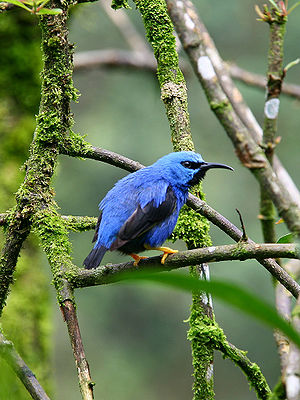Azure Ash Bird
| Azure Ash Bird | ||||||||||||
|---|---|---|---|---|---|---|---|---|---|---|---|---|

Azure ash bird ( Cyanerpes lucidus ) |
||||||||||||
| Systematics | ||||||||||||
|
||||||||||||
| Scientific name | ||||||||||||
| Cyanerpes lucidus | ||||||||||||
| ( Sclater & Salvin , 1859) |
The Shining Honeycreeper or Gelbfuß-honeysuckers ( Cyanerpes lucidus ) is a bird art from the family of tanagers .
description
The Azure Ash bird reaches a body length of up to 10 cm and weighs between 10 and 11 grams. The most striking feature of both sexes is the black, narrow and slightly curved beak . The legs are bright yellow and have black claws. The easiest way to differentiate between the sexes is the color of the plumage. The plumage of the male is purple, sometimes with a bluish tinge. The wings, the neck area, the tail and the visual field between the eyes and the base of the beak are colored black. In the female, the back side is greenish in color. The head area is also colored green, but has a bluish tinge. A light brown shimmer can appear on the sides of the neck. Ventrally, the plumage is bluish in color. Young birds are essentially similar to females, but they have a higher proportion of blue in the head and chest area. The adult coloring of the plumage begins with sexual maturity, usually at the beginning of the second year of life.
distribution
The azure ash bird is common in large parts of tropical and subtropical Central America. The main distribution area includes Belize , northwestern Colombia , Costa Rica , Guatemala , Honduras , southern Mexico , Nicaragua and Panama . The natural habitat is essentially limited to the humid plains. The species is particularly common in sparse forests and forest edges. It can also be found in the vicinity of humans, especially on cocoa and citrus plantations.
nutrition
The Azurnaschvogel feeds mainly on nectar , in smaller quantities also on ripe berries and small insects . The chicks are only fed insects. The beak is optimally designed for the intake of nectar. A convergence phenomenon with the hummingbirds cannot be denied. In contrast to the hummingbirds, the azure ash bird does not ingest the nectar in flight, but rather sits on a branch while it is eating. The search for food takes place mainly above the treetops.
Reproduction
Azure ash birds reach sexual maturity at the beginning of the second year of life. The mating season begins in spring and can extend into early summer. The female builds a bowl-like nest in a tree . It is only sparsely padded. The clutch consists of two eggs that are incubated by the female for 12 to 13 days. The nestling period is around two weeks. In the third week of life, the young birds fly out. Azure ash birds can live up to ten years.
Subspecies
Danger
The Azurnaschvogel is listed as Least Concern in the IUCN Red List .
literature
- Gottfried Mauersbergen, Wilhelm Meise: Urania Tierreich , 7 vols., Birds. Urania, Stuttgart 1995
- Bernhard Grzimek: Grzimeks animal life . Volumes 7-9, birds. Deutscher Taschenbuchverlag GmbH & Co. KG, Munich 1993
- https://www.zootierliste.de/?klasse=2&ordnung=227&familie=22781&art=2222321
Web links
- Cyanerpes lucidus in the endangered Red List species the IUCN 2011. Posted by: BirdLife International, 2009. Accessed November 14, 2011th